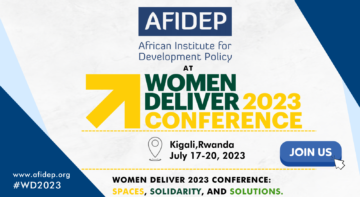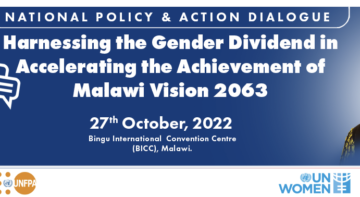Blogs

The negative effect of harmful traditional practices on the sexual and reproductive health and rights of girls and women is well documented. In Kenya, such practices include: early marriage, female genital mutilation (FGM), and sexual and gender-based violence. While there has been a reduction in the incidence of these practices, they are still widely practiced in some communities and remain major barriers to improving the health and wellbeing of girls and women in Kenya.
The 2014 Kenya Demographic and Health Survey (KDHS) reported that the national median age by first marriage among women aged 25-49 is 20 years. This means that half of women in Kenya marry by this age. However, in 13 of 47 counties, 1 in every 2 women marry before age 19 years. In addition, one in ten girls aged 15-19 in Kenya has undergone circumcision. However, 12 counties have higher rates of female circumcision ranging from 17 percent to 99 percent.
To further understand the nature of harmful traditional practices, their prevalence in Kenya and the interventions that have been implemented to curb their presence, we speak with Ms. Violet Murunga, a Senior Knowledge Translation Officer at AFIDEP.
What are harmful traditional practices (in the context of sexual and reproductive health)?
These are activities stemming from deeply entrenched discriminatory views about the role and position of women and girls in society that result in unequal power relations between men and women, relegating women to an inferior position relative to men.
Other than what can be deduced from this definition, what is the larger concern about harmful traditional practices?
Harmful traditional practices legitimise and perpetuate various forms of violence against women including FGM, forced feeding of women to make them [visually] pleasing to men, early marriage, the various taboos or practices that prevent women from controlling their own fertility, son preference, female infanticide, early pregnancy and bride price, among others. The outcome is that women often fail to achieve their full potential as productive members of society because these discriminatory views and harmful practices result in their unequal access to education, healthcare, economic opportunities and leadership positions.
Which are the main forms of harmful traditional practices in Kenya?
FGM; early marriage, various taboos or practices which prevent women from controlling their own fertility, early pregnancy, son preference, and dowry, although national advocacy efforts do not necessarily define all these practices as “harmful’ per se but rather obstacles to women’s progression in society. FGM and early marriage are considered as “harmful’ alongside the emotional, sexual and physical abuse of women and girls, which are defined as sexual and gender-based violence. National advocacy efforts therefore mainly focus on eliminating FGM, early marriage and sexual and gender-based violence as well as promoting girls’ and women’s equal access to education, healthcare and economic opportunities, and promoting their sexual health and rights.
What is the prevalence of these practices and their effects in Kenya?
Reporting on harmful traditional practices is limited to FGM, early marriage and sexual and gender-based violence. According to the 2014 (KDHS), early marriage has declined over the past two decades. Between 1993 and 2014, the proportion of women who married at age 15 declined from 13 percent to 8 percent and those who married at age 18 declined from 41 percent to 29 percent. However, in a few counties, namely, Migori, Tana River and Homa Bay, marriage below age 18 is still common with half of women aged 25-49 years marrying by age 17. Similarly, despite a decline in FGM over the past two decades, still 1 in 10 (12 percent) girls aged 15-19 in Kenya have undergone circumcision with significant variations at sub-national level. FGM is rampant in some counties and not in others. Twelve counties have FGM rates above the national average and of these, FGM is nearly universal in three counties namely Nyamira (78 percent), Kisii (84 percent) and Garissa (99 percent). The 2014 KDHS also indicates that more girls than boys experience sexual violence (6.5 percent of girls compared to 2.7 percent of boys aged 15-19 years). While this signifies a decline of almost 50 percent from what was recorded in the 2008/09 KDHS, it remains a key issue of concern.
What are the most effective interventions in curbing these harmful practices?
When you look at evidence on effective interventions for curbing harmful traditional practices, the strongest evidence suggests that integration of gender perspectives into education at all levels would have far reaching effects on reducing all kinds of harmful traditional practices.
In addition, it is likely to be cost-effective even though this aspect of the evidence unclear. But the fact that education as a social service is widely available in Kenya, it is safe to say that this is a low hanging fruit the country could easily leverage on. Notably, Kenya is in the process of reforming its basic education curriculum, which offers a great opportunity for this intervention to be incorporated. Interventions being implemented by groups such as Forum for African Women Educationalists (FAWE) are illustrating the benefits of improving access to gender-responsive education for girls from communities where FGM and early marriage are common.
In addition, there have been some targeted interventions for communities that practice FGM, which, while they have not yet been proven effective, show promise of effectiveness. Most of the promising interventions have largely engaged religious and community leaders, who are influential in shaping the beliefs and norms related to the practice, and some positive outcomes have been illustrated.
What difficulties have been experienced in the delivery of these interventions?
Deeply-rooted beliefs and norms are a major challenge and these need to be transformed in order for change to occur. Changing behavior is difficult. When behavior is rooted in a cultural belief it is nearly impossible to change, although, based on the evidence, improving access to gender-responsive education for girls and women from such communities is probably the most sustainable approach and the one that would have the greatest impact. In addition, educating religious leaders, boys and men in these communities on the need to eradicate harmful traditional practices is also critical for the success of these interventions.
What opportunities would you say the 2015 National Adolescent Sexual and Reproductive Health (ASRH) Policy presents in the fight against harmful traditional practices in Kenya?
The policy has five principles, the first of which is the respect for human rights and fundamental freedoms including the right to life, human dignity, equality and freedom from discrimination on the basis of gender, sex, age, disability, health status, geographical location or social, cultural and religious beliefs and practices. This offers a great basis with which to be able to intensify efforts to eliminate harmful traditional practices. Another key principle of the policy is to use evidence-based interventions and programming, which means that we can look forward to more effective interventions being adopted and scaled up. The policy also has five broad objectives, one of which aims to increase gender equity and equality in sexual and reproductive health amongst adolescents. Finally and most importantly, reduction of harmful traditional practices is one of the priority focus areas of the policy.
Related Posts





